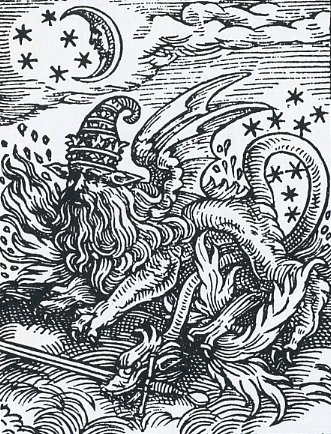The TOLKIEN
GALLERY
page EIGHT
~
B a l r o g s
and
other
F/ i| r\
e Spirits
 <–––
BALROG
<–––
BALROG
as portrayed in the first LotR movie Fellowship of the Ring,
produced by Peter Jackson. This primeval
fire-spirit beast is immortal, although - by assuming material form -
it can
be 'killed' ... indeed, a Balrog was killed by Glorfindel in the battle
for Gondolin in the First Age, and another Elven Lord - Ecthelion -
died killing Gothmog, the Lord of the Balrogs, in the same battle.
In the film the Wizard Gandalf is dwarfed by the size of this
creature
as he confronts it on the Bridge of Khazad-dûm. Still, they faced
each other as equals, both being of the Ainur originally from the
Undying Lands. Gandalf calls up the fire of Arnor
as an authority against the demon.
*
* * *

In the early animated Bakshi film of The Lord of the Rings,
the Balrog was portrayed less as 'fire' and more as a fiercely dark and
beastly demon.
*
* * *
The idea of primeval fire-spirits did not originate with Professor
Tolkien, however. At one time in the emerging quest for scientific
doctrine, it was believed that creation was comprised of four basic elements: earth, water, air and fire
[for a narrow exposition of this idea see the page on The Rings of
Power.] The spirit - or Elemental
- of fire became known as the Salamander.

<––– SALAMANDER
[Book of Lambspring, Musaeum Hermeticum, 1749]
It appears unclear where the salamander became an elemental of fire.
The idea is generally accepted as originating with Theophrastus
Paracelsus [c. 1490 - 1541].
However, the ancient Greeks thought of the zoological salamander as
associated with fire - perhaps because the creatures nested in fallen
wood and would emerge when the brands were burned - and they had a
reputation for being able to extinguish a fire by the natural coolness
of their bodies.
*
* * *
 To the
left is a rendering of a salamander
by Paracelsus [Auslegung von 30
magischen Figuren, Complete
Writings of..., Strasbourg, 1616]; it is notable as an
interpretive piece. The figure wears a crown [of Occidental styling?]
signifying its high position
within creation; the [wizard's?] crest reaches unto the celestial
bodies, including the Moon and stars. The face is human, indicating a
nature that partakes of both the beastial [the ears] and the Divine.
The body is that of a lion - or griffon - with its claws implanted in
the Earth. The tail ends in a dragon's head gripping a sword,
indicating the 'secret fire' of the Hermeticist.
To the
left is a rendering of a salamander
by Paracelsus [Auslegung von 30
magischen Figuren, Complete
Writings of..., Strasbourg, 1616]; it is notable as an
interpretive piece. The figure wears a crown [of Occidental styling?]
signifying its high position
within creation; the [wizard's?] crest reaches unto the celestial
bodies, including the Moon and stars. The face is human, indicating a
nature that partakes of both the beastial [the ears] and the Divine.
The body is that of a lion - or griffon - with its claws implanted in
the Earth. The tail ends in a dragon's head gripping a sword,
indicating the 'secret fire' of the Hermeticist.
This figure is often compared to the Phoenix, a fanciful bird that
arises in flames from its own ashes to live again and again.
*
* * *

Another fanciful representation of the ELEMENTALS of fire by ––>
hermeticist Manly P. Hall [The Secret Teachings..., 1977
{with some
coloring interpretation by this author}].
The Roman author Pliny claims to have once tried the proof of the
salamander legend, but the creature, alas, was immediately consumed by
the fire. In the first part of Henry IV, Shakespeare
wrote: I have maintained that
salamander of yours with fire any time this two-and-thirty years.
 <–––
BALROG
<–––
BALROG <–––
BALROG
<–––
BALROG

 To the
left is a rendering of a salamander
by Paracelsus [Auslegung von 30
magischen Figuren, Complete
Writings of..., Strasbourg, 1616]; it is notable as an
interpretive piece. The figure wears a crown [of Occidental styling?]
signifying its high position
within creation; the [wizard's?] crest reaches unto the celestial
bodies, including the Moon and stars. The face is human, indicating a
nature that partakes of both the beastial [the ears] and the Divine.
The body is that of a lion - or griffon - with its claws implanted in
the Earth. The tail ends in a dragon's head gripping a sword,
indicating the 'secret fire' of the Hermeticist.
To the
left is a rendering of a salamander
by Paracelsus [Auslegung von 30
magischen Figuren, Complete
Writings of..., Strasbourg, 1616]; it is notable as an
interpretive piece. The figure wears a crown [of Occidental styling?]
signifying its high position
within creation; the [wizard's?] crest reaches unto the celestial
bodies, including the Moon and stars. The face is human, indicating a
nature that partakes of both the beastial [the ears] and the Divine.
The body is that of a lion - or griffon - with its claws implanted in
the Earth. The tail ends in a dragon's head gripping a sword,
indicating the 'secret fire' of the Hermeticist.